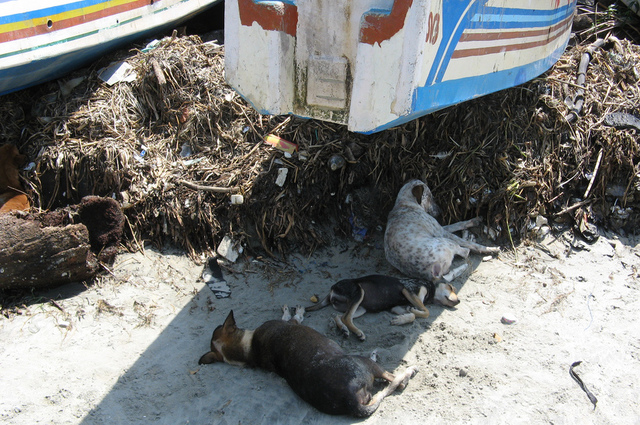24/08/2016
Man’s best friend has become his worst enemy in Kerala.
India’s most advanced state – with the best healthcare, education and social security systems in the country -- is struggling to deal with stray dogs, rather ironically. The menace has reached unimaginable proportions: a 65-year-old woman was mauled to death by a pack of strays on a beach near Thiruvananthapuram last week. Pick up a newspaper, and you feel you are in dog’s own country where fierce canines are running amuck. It’s getting as bizarre as what the great M.P. Narayana Pillai put in his classic novel Parinamam. Are dogs ganging up against humans?
A report by an official panel puts the number strays at 250,000 in the state and incidents of dog bites at more than 100,000 a year. Stories of dog aggression on hapless humans galore in local media. The situation is perceived to be so grave that Chief Minister Pinarayi Vijayan has held meetings with various departments on how to tackle the canines that nobody owns. Public anger is rising against animal lovers, especially federal minister Maneka Gandhi and her People For Animals, as they oppose killing dogs.
Under the Prevention of Cruelty to Animals Act, dogs can be killed only under three situations: 1) they are rabies infected; 2) incurably ill; and 3) mortally wounded. Still, large-scale culling of the strays seems to be the only solution that many, including some mainstream newspapers, advocate to end the dog menace in the state. WhatsApp messages on methods to kill dogs are spreading, as if urging people to start an armed rebellion against mutts since the law is of little help. Apparently, in many places, youngsters have formed teams to decimate the mongrels. Yesterday, the government asked corporations and municipalities to kill dangerous dogs.
It’s primitive, barbarian, impractical and utterly useless to go on an indiscriminate killing spree to tackle the problem of pooches. It hasn’t worked anywhere in the world when authorities tried to get rid of strays by culling them; it has only compounded the problem and led to more serious ones. To be sure, nobody supports the idea of dogs on the loose and biting people. Dogs, or for that matter any animal, seen as a threat to humans should be eliminated. But before we start a mass extermination, we must resolve some fundamental issues that created the dog menace in the first place.
The primary reason for the current problem is our failure to have an effective waste management mechanism in cities and towns. As houses with large compounds shrank to apartments and villas, we lack the space needed to dispose of leftovers. We conveniently throw the waste out as we go for an evening drive. The result: every nook and cranny of Kerala is a dumping yard. Not just leftover food, even waste from slaughter houses are dumped on the roadside, beaches and open spaces. Dogs scavenge on the waste, multiply, and form packs. Once a pack is formed, a leader emerges, usually an alpha-male dog, as in the natural course in the canine world. Just like the mob mentality in humans, it is the pack that often becomes vicious with the pack leader showing the way. Dogs that are alone or in small groups seldom attack humans. So if we address the issue of dumping waste, it goes a long way in reducing the man-dog conflict.
“We’ve created a conducive environment for dogs to become feral animals,” says Shibu K. Nair, an expert in waste management. “They feast on the rotten meat we dump, and it’s this easy availability of food that makes them wild and attack people since they are no longer dependent on humans for food. It’s like they are back in the jungle.”
On the other hand, what will happen if we eliminate street dogs and continue to throw waste everywhere? Something else will feed on it. You get rid of one scavenger and the next in line will rise, and it’s usually rodents. One kilogram of waste can feed two or three dogs or as many as 40 rats. Remember the outbreak of plague in Surat in 1994 that left more than 50 people dead? Now it’s established that the move to kill the stray dogs in the city caused a surge in rats and the subsequent deadly epidemic. In a developing country like India, stray dogs form an important part in the ecosystem. The Gujarat government later reintroduced the dogs in Surat in order to avoid a return of the outbreak. Even in developed nations, the removal of street dogs has led to other problems. For instance, the U.K. is contending with foxes in its cities.
The method of dog catching at our corporations and municipalities has its own shortcomings. Many vets say the dog catchers end up snaring the weak and friendly animals, sometimes even puppies, while the feral dogs almost always get away. Dogs are highly perceptive and intuitive animals that have a strong sense of danger. When we hunt down dogs, it’s natural that they become more suspicious of humans and attack at the slightest provocation. It’s the survival instinct. As for the number of dog attacks, animal right activists allege that more than 75% of the reported bites were from pet dogs, but the mainstream media never highlight this, putting the entire blame on strays.
Veterinary doctors also point out that through the large-scale massacre, we are eliminating the local breeds, the sturdiest and fittest landraces best suited for our climate. As such, so many native Indian breeds such as the Rajapalayam are almost extinct. If we continue the indiscriminate culling, soon we will lose the unique gene pool of the native dog. That will be an irreversible mistake.
So what’s the solution? We need a multi-pronged approach, and it is certainly doable. A sustained mass sterilization program that lasts for a few years, and not for a few weeks, is the first step. According to estimates, the sterilization of one female dog prevents 67,000 births over seven years. Experts say sterilization also does away with most of the aggression in dogs. (Male dogs are more aggressive during mating season and females when they have pups. Also, often packs are formed around a fertile female, and neutering that dog will disintegrate the pack.) Sterilized and vaccinated dogs should have clear identification tags. Pet dogs should be licensed and strict penalties be imposed for abandoning pets. But the biggest challenge is ensuring that slaughter and domestic waste aren’t dumped everywhere. Unfortunately, we are shying away from dealing with such tasks, and turning toward easier options such as mass killing of the dogs.
(Photo credits: Abhijith B.Rao via Foter.com / CC BY-NC-SA mosilager via Foter.com / CC BY-NC-SA Dey via Foter.com / CC BY-NC-SA andedam via Foter.com / CC BY-NC-SA)



